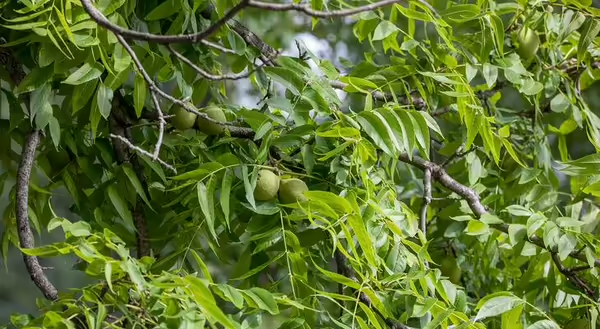
Anyone with a mature black walnut (Juglans nigra) on their property is likely aware that fruits are ripe now, and the baseball-sized, green bombs are beginning to fall with each slight gust of wind or, at times, seemingly at random. This native tree is prevalent throughout central Illinois, thriving on our deep, fertile soils to reach heights up to 100 feet. When compared to other Illinois forest denizens, black walnut has some unique and interesting characteristics that set it aside from others.
Black walnut fruits consist of a thick, green hull that protects a shell that harbors chambered nut meat that is edible to humans and wildlife. The hull material has the unmistakable smell of walnut and serves as the first line of defense against predators. If you start to remove this material, be prepared for a sticky, aromatic green to dark brown or black coating on anything it touches, which does contain a powerful dye. Native Americans used husk material for a variety of uses, from cleaning wounds and de-worming dogs to dying hair and garments. Some used a concoction of walnut husk, rubbed on livestock to protect against parasites and other pests. Nut meat was eaten fresh or added to many dishes, making this tree an important part of many tribe’s diets.
Black Walnuts vs. English Walnuts
Although black walnut is an important commercial crop in the U.S., most of the walnuts we purchase at retail outlets are from the English (AKA Persian) walnut (Juglans regia). English walnut has thinner, easier-to-crack shells and slightly milder flavor, which has made them more popular globally. However, I would contend that you cannot beat the flavor of our native walnut. It’s a more complex and rich flavor and is widely available for free, if you are willing to shell it. Although English walnuts are slightly higher in health boosting omega-3 fatty acids, the black walnut is slightly higher in protein content. All in all, the walnut has a high amount of protein along with omega-3 fatty acids, which is relatively rare in the tree nut world. Most other nuts are high in one nutritional element at the expense of the other.
Juglone: A Compound that Protects the Walnut, but Harms Other Plants
Perhaps the most interesting attribute of walnut trees is a compound they produce called juglone. This compound occurs in the leaves, roots, husks, and bark of plants in the Juglandaceae family, numbering some 50 species worldwide. The toxic effects of this chemical on other biota have been observed by humans for around 2,000 years, dating back to ancient Rome and Greece. The ancients knew of the fungicidal and bactericidal properties of juglone, prescribing it for various medicinal uses. Juglone also exhibits allelopathy, which is the chemical inhibition of growth and development on plants. Pliny the Elder (23-79 AD) observed, “The shadow of the walnut tree is poison to all plants within its compass.”
Roots from walnut trees, decomposing husks, and juglone-laden fall out from walnut leaves are able to inhibit the growth of competing vegetation, making the forest understory environment near walnut trees composed of different (juglone tolerant) plants than other areas of the forest. Similar to the effects on forest plants, walnut root systems can impact ornamental or garden plants. Tomatoes are particularly sensitive to this compound, making the large walnut tree near my garden area somewhat of a threat. Signs of allelopathic effects of walnut include wilting and yellowing of leaves or overall poor growth.
Disease and Walnut Trees
Walnut is a highly valued timber species, making it an important commercial product of the central hardwoods forest. A newly recognized disease, as of the early 2000s, threatens the existence of black walnut populations across the U.S. Thousand cankers disease is a disease complex native to the western U.S. that results from the combined activity of the walnut twig beetle (Pityophthorus juglandis) and a fungus (Geosmithia morbida) that, upon beetle introduction of the fungus to walnut stems, disrupts sap flow and ultimately kills the tree. Similar to emerald ash borer, the spread of this disease has been greatly attributed to human transport of infected firewood.
Time will only tell whether or not this pathogen will inundate Midwestern forests. To date, it has devastated walnut populations in many states west of the continental divide. However, isolated discoveries in Tennessee, Pennsylvania and Virginia suggest it may be expanding to the heart of the black walnut’s native range.
Although I fear the potential impacts of juglone from the walnut tree near my garden, I am reluctant to cut it down for fear it may be a rare native species someday. So, if you have a walnut that seems problematic, either from dropping green bombs or inhibiting the growth of garden plants, take a few minutes to enjoy this native species for its more unique qualities before you curse it.